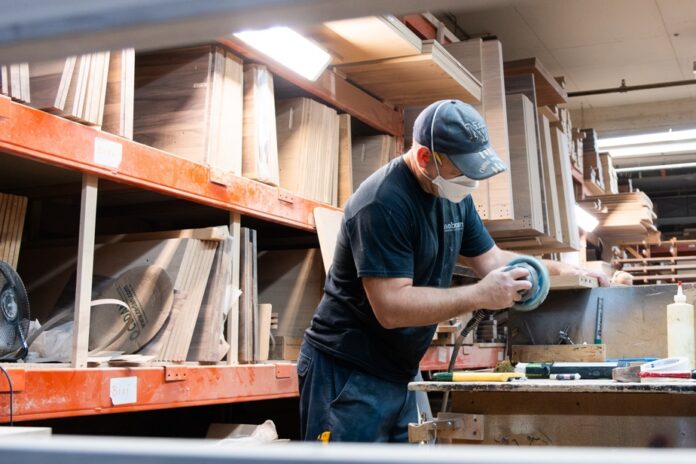What is the biggest barrier to innovation? It’s comfort! At least that’s the opinion of François Gingras, vice-president of Investissement Québec-CRIQ, which supports companies in industrial innovation. Overview.
“Many entrepreneurs are in their comfort zone, the profits are there, so they ask themselves why innovate,” he notes. But it’s dangerous to wait until things go wrong before innovating. You have to continue to carry out your daily activities at the same time as carrying out an innovation project, so it’s demanding and it takes time before you see results. »
Patrick Selmay, co-founder of Mobican, a furniture company in Saint-Jean-sur-Richelieu, quickly realized that he could not rest on his achievements.
For example, seven years ago, he ordered a machine from a European furniture manufacturer to carry out two operations: the preparation of the panels and the application of the edge banding (the edge). “It’s something we developed together and there were some big technological challenges to overcome,” he explains. It took almost three years of work before it worked perfectly. We and the manufacturer had to be persistent, but once it was finished we were really happy. »
As virtually all furniture manufactured at Mobican passes through this machine, the efficiency gain is considerable in this SME of around 50 employees. “This saves around 30 hours of work per week, which is important in a context of labor shortage,” explains Patrick Selmay. We are more cost competitive and we also have greater production capacity. »
Mobican, which sells its furniture in Canada and the United States, is also innovating with its products. Recently, the company has integrated chargers for mobile devices and lighting into its bedroom furniture.
“I am lucky that my two guys, Mathieu, a civil engineer who is very interested in design, and Nicolas, a mechanical engineer who is more interested in production and equipment, help me a lot to support the innovation, says Patrick Selmay, who founded the company with his father in 1988. We also often welcome interns in engineering or engineering techniques. Innovation is part of our DNA. We will also move to a larger factory at the end of 2024 to be able to push innovation even further in terms of equipment and processes. »
Having a successful first innovation project is a key element in a company’s journey.
“This is what generally makes an entrepreneur and his team want to continue to develop innovative projects,” remarks François Gingras.
Same story from Pascal Monette, president and CEO of the Association for the Development of Research and Innovation of Quebec (ADRIQ).
To avoid falling into the trap of the status quo, one strategy is to assign employees to innovation.
“There are always things happening in a company and it’s easy for employees to just work on more pressing projects that will produce quicker results,” explains François Gingras.
Moreover, innovation, whether through digital transformation or the development of new products, should always be part of the company’s strategic plan. “The chosen tool must enable a business objective to be achieved,” he adds. To make this decision, you must first analyze your needs. The company’s major objectives should never be disconnected from its technological plan. »
“Training is also important,” adds Pascal Monette. Often, the managers of an SME know their products and their sector of activity well, but they are not trained in innovation management. They can seek out a little additional training or support. In this way, they will be able to develop a more strategic vision of innovation. This is not a weekend project, but the development of an entire culture. »
A company with deficient governance often has difficulty developing a strong culture of innovation, notes Pascal Monette, CEO of ADRIQ. “It makes sense because an entrepreneur who has good governance has an advisory committee, or a board of directors. This means he is not alone. He has qualified people to report to and with whom to discuss several times a year about the objectives to be achieved and the obstacles encountered. This helps him enormously to think and move forward. »
While many entrepreneurs are approaching retirement, François Gingras, vice-president of Investissement Québec, notes that many say they are too old to innovate and want to leave that to the next generation. “But it’s dangerous, because the competition doesn’t stop innovating. Additionally, we often underestimate how well-positioned experienced people are to innovate. Yes, young people know technology, but the most important thing to properly automate a process is to know it well. Otherwise, we risk automating something inaccurate and ending up with defective products faster than ever! »
Companies have had to deal with several emergencies in recent years and this may also have slowed down certain innovation projects. “There were all the rules imposed by the government with COVID, then certain companies had liquidity problems, supply issues, an explosion in their demand,” lists Pascal Monette. Business leaders have had a lot of things to manage in a hurry, so it is certain that sometimes, they have had to put certain innovative projects on ice. »
If the labor shortage has encouraged many companies to accelerate major automation and robotization projects, it has slowed down others. “Companies already had a lot of urgent problems to manage in recent years, this was done in a situation of great labor shortage,” indicates Pascal Monette. It is certain that companies were not able to do everything at the same time, and several innovation projects were stopped for this reason. But there, we feel that they are starting again. »















